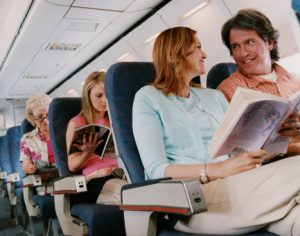 The colder weather has many of us wishing for sunny skies and sandy beaches, but before you hop on that plane to your winter getaway, it may be beneficial to review these travel tips to keep you germ-free on your flight. Planes put large groups of people from different areas together in close proximity and may increase your chance of picking up a cold or flu from another traveler. One study published in the Journal of Environmental Health Research has claimed that you are 100 times more likely to catch a cold on a plane than you are to catch one in everyday life, so how can you lower this risk? Below are five tips to help you stay germ-free while on a plane so that you can enjoy your vacation without the annoyance of a new cold or flu.
The colder weather has many of us wishing for sunny skies and sandy beaches, but before you hop on that plane to your winter getaway, it may be beneficial to review these travel tips to keep you germ-free on your flight. Planes put large groups of people from different areas together in close proximity and may increase your chance of picking up a cold or flu from another traveler. One study published in the Journal of Environmental Health Research has claimed that you are 100 times more likely to catch a cold on a plane than you are to catch one in everyday life, so how can you lower this risk? Below are five tips to help you stay germ-free while on a plane so that you can enjoy your vacation without the annoyance of a new cold or flu.
Five tips to avoid getting sick while flying
The dry, recirculated air and close proximity to other passengers can make a long flight the perfect opportunity for you to catch an illness. Lower your risk by following these five tips:
Advertisement
Practice good hygiene. It may sound like a no-brainer, but good hygiene is the key to remaining germ-free in any environment. Make sure you thoroughly wash your hands after using the washroom and before eating. Pack a small bottle of hand sanitizer in case you are unable to get to the bathroom and wash your hands before any meals or snacks. Also, include some anti-bacterial wipes in your carry-on so you can disinfect the armrests and tray tables as well as any other surfaces you may come into contact with. Finally, do your best to avoid touching your face and mouth to prevent the transfer of germs.
Stay hydrated. Your mucous membranes can dry out on a long flight due to low humidity levels in the cabin, making them more vulnerable to germs and bugs. Drinking plenty of bottled water can help prevent this dryness and reduce your chances of picking up an illness. Alcohol and caffeine can contribute to dehydration, so limit your intake of these substances.
Avoid the aisle. While many may prefer the aisle seat—as it is easier to get up from during the flight—avoiding this position may actually help reduce your exposure to germs. This is because the aisle seat puts you in closer proximity to a greater amount of people as they pass by to get to the bathroom or stretch their legs. Similarly, it is not uncommon for those walking down the aisle to touch each chair or armrest as they pass for balance, potentially transporting germs from one row to the next without realizing.
Bring your own blanket. Some airlines provide blankets and pillows for travelers, but bringing your own is the more hygienic option. This is because there’s a chance that the airline-provided items may have been reused between flights without being properly washed, meaning you may be exposing yourself to other people’s germs by resting your head on that pillow or pulling the blanket up to your chin. Invest in your own portable travel pillow and blanket set—they can be found at prices suitable for any budget and will reduce your risk of getting sick.
Change seats. While this option is not always possible—especially on a full flight—changing seats to distance yourself from a passenger who is coughing or sneezing can reduce your risk of catching their illness. It is best to politely ask a member of the cabin crew if there is another seat available rather than just choosing one for yourself, as they may prefer that you stay in your assigned seat for safety reasons.
Traveling can be an exciting and fun experience, but not if you get sick before you even step off the plane. Washing your hands frequently, packing disinfectant wipes, staying hydrated, bringing your own comfort items, and choosing an aisle seat away from any ill passengers are all ways to reduce your risk of catching any potential sickness that may ruin your vacation.
Related: Healthy Tips For Travellers
